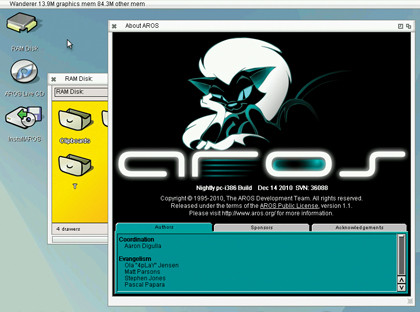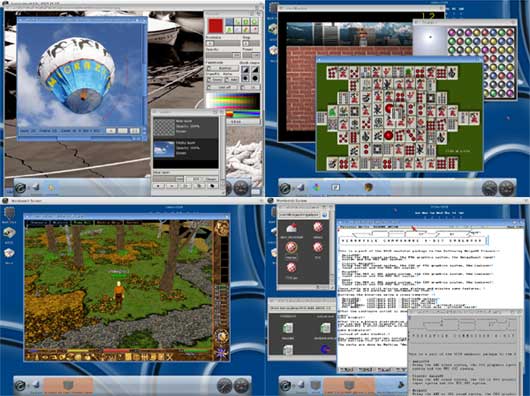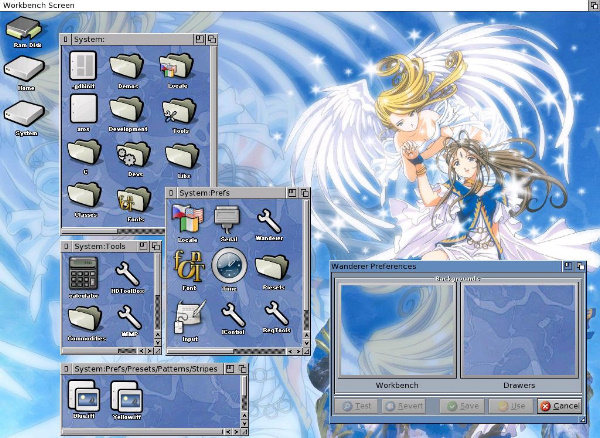AROS : The x32 OS for Amiga Fans
AROS (Arrow OS)
If you loved the Amiga you will love this new OS

You may have fond memories of the Amiga. The dazzling graphics and crisp sound (when PCs were faffing around with text mode and beeps), the super-fast multi-tasking, and the, er, lack of protected memory…
Well, forget that last one. It was one of the best-loved computers of all time, and it still has many fans today.
AROS - the Amiga Research Operating System - is intensely fast. Blisteringly so. It apes the Amiga design, both superficially and with its inner workings, and is designed to be source compatible with AmigaOS 3.1 (software written for the old Amiga OS should only need a recompile to work).
AROS has great potential as a light and fast OS for low-end netbooks and tablets

Short introduction to AROS
Introduction
The AROS Research Operating System is a lightweight, efficient and flexible desktop operating system, designed to help you make the most of your computer. It's an independent, portable and free project, aiming at being compatible with AmigaOS at the API level (like Wine, unlike UAE), while improving on it in many areas. The source code is available under an open source license, which allows anyone to freely improve upon it.
Goals
The goals of the AROS project is it to create an OS which:
Is as compatible as possible with AmigaOS 3.1.
Can be ported to different kinds of hardware architectures and processors, such as x86, PowerPC, Alpha, Sparc, HPPA and other.
Should be binary compatible on Amiga and source compatible on any other hardware.
Can run as a standalone version which boots directly from hard disk and as an emulation which opens a window on an existing OS to develop software and run Amiga and native applications at the same time.
Improves upon the functionality of AmigaOS.
To reach this goal, we use a number of techniques. First of all, we make heavy use of the Internet. You can participate in our project even if you can write only one single OS function. The most current version of the source is accessible 24 hours per day and patches can be merged into it at any time. A small database with open tasks makes sure work is not duplicated.
History
Some time back in the year 1993, the situation for the Amiga looked somewhat worse than usual and some Amiga fans got together and discussed what should be done to increase the acceptance of our beloved machine. Immediately the main reason for the missing success of the Amiga became clear: it was propagation, or rather the lack thereof. The Amiga should get a more widespread basis to make it more attractive for everyone to use and to develop for. So plans were made to reach this goal. One of the plans was to fix the bugs of the AmigaOS, another was to make it an modern operating system. The AOS project was born.
But exactly what was a bug? And how should the bugs be fixed? What are the features a so-called modern OS must have? And how should they be implemented into the AmigaOS?
Two years later, people were still arguing about this and not even one line of code had been written (or at least no one had ever seen that code). Discussions were still of the pattern where someone stated that "we must have ..." and someone answered "read the old mails" or "this is impossible to do, because ..." which was shortly followed by "you're wrong because ..." and so on.
In the winter of 1995, Aaron Digulla got fed up with this situation and posted an RFC (request for comments) to the AOS mailing list in which he asked what the minimal common ground might be. Several options were given and the conclusion was that almost everyone would like to see an open OS which is compatible with AmigaOS 3.1 (Kickstart 40.68) on which further discussions could be based, to see what is possible and what is not.

So the work began and AROS was born.
If you loved the Amiga you will love this new OS

You may have fond memories of the Amiga. The dazzling graphics and crisp sound (when PCs were faffing around with text mode and beeps), the super-fast multi-tasking, and the, er, lack of protected memory…
Well, forget that last one. It was one of the best-loved computers of all time, and it still has many fans today.
AROS - the Amiga Research Operating System - is intensely fast. Blisteringly so. It apes the Amiga design, both superficially and with its inner workings, and is designed to be source compatible with AmigaOS 3.1 (software written for the old Amiga OS should only need a recompile to work).
AROS has great potential as a light and fast OS for low-end netbooks and tablets

Short introduction to AROS
Introduction
The AROS Research Operating System is a lightweight, efficient and flexible desktop operating system, designed to help you make the most of your computer. It's an independent, portable and free project, aiming at being compatible with AmigaOS at the API level (like Wine, unlike UAE), while improving on it in many areas. The source code is available under an open source license, which allows anyone to freely improve upon it.
Goals
The goals of the AROS project is it to create an OS which:
Is as compatible as possible with AmigaOS 3.1.
Can be ported to different kinds of hardware architectures and processors, such as x86, PowerPC, Alpha, Sparc, HPPA and other.
Should be binary compatible on Amiga and source compatible on any other hardware.
Can run as a standalone version which boots directly from hard disk and as an emulation which opens a window on an existing OS to develop software and run Amiga and native applications at the same time.
Improves upon the functionality of AmigaOS.
To reach this goal, we use a number of techniques. First of all, we make heavy use of the Internet. You can participate in our project even if you can write only one single OS function. The most current version of the source is accessible 24 hours per day and patches can be merged into it at any time. A small database with open tasks makes sure work is not duplicated.
History
Some time back in the year 1993, the situation for the Amiga looked somewhat worse than usual and some Amiga fans got together and discussed what should be done to increase the acceptance of our beloved machine. Immediately the main reason for the missing success of the Amiga became clear: it was propagation, or rather the lack thereof. The Amiga should get a more widespread basis to make it more attractive for everyone to use and to develop for. So plans were made to reach this goal. One of the plans was to fix the bugs of the AmigaOS, another was to make it an modern operating system. The AOS project was born.
But exactly what was a bug? And how should the bugs be fixed? What are the features a so-called modern OS must have? And how should they be implemented into the AmigaOS?
Two years later, people were still arguing about this and not even one line of code had been written (or at least no one had ever seen that code). Discussions were still of the pattern where someone stated that "we must have ..." and someone answered "read the old mails" or "this is impossible to do, because ..." which was shortly followed by "you're wrong because ..." and so on.
In the winter of 1995, Aaron Digulla got fed up with this situation and posted an RFC (request for comments) to the AOS mailing list in which he asked what the minimal common ground might be. Several options were given and the conclusion was that almost everyone would like to see an open OS which is compatible with AmigaOS 3.1 (Kickstart 40.68) on which further discussions could be based, to see what is possible and what is not.

So the work began and AROS was born.
- Code: Select all
http://aros.sourceforge.net
